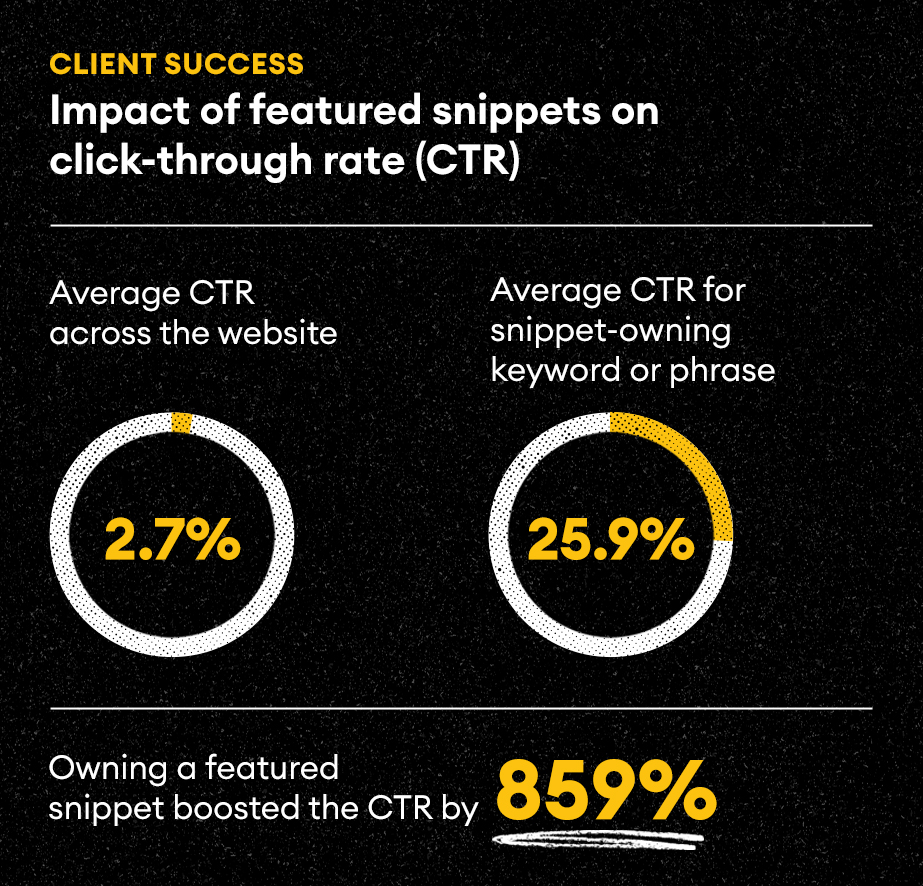This blog, originally published in January 2023, has been refreshed to reflect the latest insights into how winning featured snippets can enhance your visibility in Google’s evolving search results, particularly in the context of AI-generated overviews.
Google’s organic search experience is designed to put users first. New search features and refined results connect users with what they need to make educated decisions about everything from what products to purchase to what site presents the most authoritative information needed to solve a problem. Google rolled out featured snippets to the search engine results pages (SERPs) in 2018 and has since transformed the way information is accessed and user questions are answered.
Even several years after launch, featured snippets and the strategy behind them come with many benefits. From increased click-through rates to enhanced user trust, winning a snippet puts you at a major advantage over competitors vying for the same keyword. And as we welcome 2025 and the AI-powered changes Google brings with its Search Generative Experience, featured snippets are even more essential to your SEO and web strategy.
As of today, nearly 20% of all searches deliver results that include a featured snippet. This makes featured snippet strategy essential to organic search rankings, customer experience, and even conversion rates. Focusing on an organic web strategy and winning featured snippets is more important to SEO now than ever, as this can help combat the increasing costs and stagnating results many businesses are seeing with paid search placements.
What are featured snippets?
Featured snippets are highly visible placements in Google’s search results that showcase concise, relevant answers directly on the search page. With Google now incorporating AI-generated overviews into its results, rich snippets have taken on even greater significance, often serving as key inputs for these summaries.
The definition of featured snippets is fairly simple. Featured snippets are extended blocks of information intended to give users a quick answer to their questions or search queries. Users might see a list, chart, or fact at the top of the page that provides instant access to the information they seek. Paragraph snippets are the most common type of featured snippet, accounting for 82% of all snippets and providing rich information to answer search queries.
You might consider featured snippet location on the SERP as “position 0,” the coveted spot between paid results and the rest of the organic results. This position is quite desirable—you can’t pay for this placement and landing here proves that Google has determined your content to be of exceptional value to the reader.

Featured snippets can mean different things to users and to content marketers.
To users, a featured snippet means their question is immediately answered and they can instantly access a web page with helpful content and authoritative information about their query.
To content marketers and SEO and UX/CX experts, featured snippets are SERP spotlights that give their quality content and web strategy an edge over the competition and should be an essential part of their digital marketing strategies.
Why are featured snippets important in SEO?
Featured snippets are more than just an important part of organic web strategy, they’re essential. There are at least four ways SEO and featured snippets can benefit your business:
- Increase web traffic and improve CTR: Our numbers show that owning a featured snippet can increase CTR by more than 850%, driving even more traffic to your website and consumers into your sales funnel.
- Boost brand awareness: Landing at the top of the SERP with extra real estate increases visibility for your brand or business. It demands consumer attention.
- Grow website authority: Featured snippets are a serious factor in building domain and page authority as they lead to better and more qualified traffic to your website.
- Optimize conversion rates: Featured snippets can usher in users who are likely to become customers by answering their questions and providing need-to-know-now information.
- Influence AI overviews: According to a report from September 2024, approximately 12% of Google searches trigger AI overviews in the search results, up significantly from just 5% in July 2024. In many of these cases, the content and link featured in the snippet also appear prominently within the AI overview box.
Another unique benefit of including featured snippets in your web strategy is related to the increasing prevalence of voice search. Voice assistants and tools like Amazon’s Echo, Apple’s Siri, and Google Home are increasingly common in many homes and vehicles. According to December 2022 reports from Statista, 35% of all households in the United States own smart speakers. Voice search queries are among the most common way users interact with these devices. And in many cases, voice search devices answer questions by citing a featured snippet.
Learn more about voice search optimization in our blog.
What do featured snippets have to do with AI overviews?
Featured snippets play a pivotal role in AI overviews on Google’s search results. Often, the same content highlighted in a featured snippet is directly referenced in the AI-enabled Search Generative Experience (SGE) summary, with the link prominently displayed. This connection makes winning a featured snippet not only a path to prime SERP placement but also a critical step toward appearing in AI-driven summaries, amplifying your content’s reach and authority.
There’s still much more to the snippet equation and Tallwave’s proprietary research proves it. Let’s look at some of Tallwave’s unique specifics and statistics about the benefits of featured snippets for your business and web strategy.
How Tallwave clients win with snippet strategy
In-depth analysis and data-fueled strategy are essential parts of Tallwave’s approach.
We put that approach to work within the organic search strategy for a large regional healthcare client to help them win featured snippets with SEO, gaining prime visibility ahead of other organic search results and enhancing the authority of their brand.
Here’s how we did it and what we learned along the way.
How can featured snippets drive growth?
Tallwave wanted to better understand what kind of content Google found “snippet-worthy” and how to apply these features to drive growth. To do this, we looked for trends and commonalities among snippet-winning content to determine what Google evaluates as high-value and the impact snippets have on website engagement.
As such, Tallwave analyzed more than 1,000 featured snippets owned by a client’s (a major healthcare provider) website in 2022. Of these 1,000 featured snippets, 98% belonged to approximately 50 posts on the website’s blog.
Tallwave started by comparing the click-through rate (CTR) for keywords that owned featured snippets to all other ranking keywords on the site. When it comes to organic searches, CTR refers to the number of impressions seen in the SERPs divided by the number of users who clicked through to the site.
For this client, the average click-through rate for a snippet-owning keyword in position one on the site was 25.9%. The average CTR across the entire website was 2.7%. Owning a featured snippet for a search term helped us boost the client’s site clicks by an impressive 859%.
Not only does a high CTR drive traffic to the site, but Google has consistently hinted its algorithm considers CTR as a ranking factor.

Snippets Have Serious Imapct on CTR
The kind of keyword that won a featured snippet was also an important consideration in Tallwave’s analysis. Out of the client’s 1,000 snippet-owning keywords, 91% represented searches with “informational” intent, implying the searcher was looking for information needed to solve a problem. Presenting the information the searcher needs when they need it establishes your business as an expert or solution, sending the searcher down the sales funnel toward converting.
While a featured snippet from Google for an informational term might not win an immediate conversion, it certainly adds to visibility and helps establish your website’s authority and business credibility. Data from HubSpot suggests it takes around eight touches to lead a customer toward conversion. A featured snippet with rich, relevant results that directly answer a consumer’s need is a high-value touchpoint and will likely help keep your brand top of mind when they are ready to take action.
What SEO factors help content win featured snippets?
In addition to analyzing the CTR and type of keywords winning snippets, Tallwave also examined factors that make a blog post or web page “snippet-worthy” in Google’s eyes. This gives us unique, specific, and proprietary information that can be applied across clients to help create content that drives awareness and promotes high-value engagement.
Here are some of the key factors we’ve uncovered in working with our clients that you should consider in your organic search strategy to help win featured snippets:
- Make keywords clear: Many blog posts with featured snippets include a primary keyword in the form of a question in the headers and body copy.
- Longtail keywords set off snippets: Longtail keywords are highly-specific search queries, often 3 to 5 words in length. These kinds of searches are more likely to trigger snippets for users seeking immediate answers.
- Prudent header placement wins: Strategically placing H2s and H3s within website content increases the likelihood of that page or post winning a snippet.
- Outperform competitors with word count: Blog posts and website pages with a competitive word count consistent with (or slightly higher than) the competition’s copy and with a specific number of words between headers (H2s, H3s) help content win snippets.
- Latent Semantic Indexing (LSI) works: Latent semantic indexing occurs when SERP results are populated based on similar and conceptual keywords. For example, a blog post about anxiety might include supporting related terms like “depression,” “mental health,” “phobias,” or “panic.” The use of these related keywords might also increase the likelihood of content owning a featured snippet.
Reap the benefits of featured snippets in your SEO strategy
The benefits of featured snippets abound. Winning featured snippets and “position 0” SERP placement directly translates into contextualized search visibility for your brand or business, increased and better-qualified website traffic, proven website authority, and, ultimately, more customer conversions.
As Google continues to refine its AI search capabilities, featured snippets remain at the forefront of SEO strategies you need in your toolbox. Their influence now extends beyond traditional search results to AI-generated overviews, making them more impactful than ever.
Providing SEO solutions and website and content strategy is just part of how Tallwave wants to drive your success. As a leader in providing integrated digital marketing solutions and more to both established and up-and-coming brands, Tallwave is ready to deploy our customer-centric and cohesive approach in a way that is unique to your vision and creates exceptional experiences for consumers of all kinds. From customer journey mapping to paid media services to product design and beyond, we’re ready to talk about how we can help your business win.






